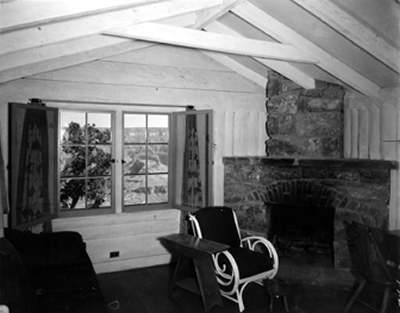The tourism industry in America was not immune to the major social and economic changes of the early 20th Century, a fact that is clearly demonstrated by the evolution of lodging facilities at Grand Canyon National Park. One of the earliest places tourists could find accommodations in what is now the Grand Canyon Village area was the Bright Angel Hotel. In 1896, tourism entrepreneur James Thurber of Flagstaff opened the hotel near the Bright Angel trailhead. He extended a stagecoach route that he helped operate to reach his site, and guided customers down the Bright Angel Trail to the Tonto Platform.
Around the turn of the century, just before the Atchison, Topeka, and Santa Fe Railway arrived nearby, Thurber sold his hotel to Martin Buggeln, a businessman from Williams, Arizona, who struck a deal with the railroad that gave them a partial interest in the hotel. Together they added a nearby tent-cabin complex called Bright Angel Camp, the precursor to the modern cabin complex.
In the early 1930s, the railway hired Mary Colter to design a new Bright Angel Lodge and develop a cluster of more permanent cabins to the west. This new lodge and cabins, which were run by the railway’s partners The Fred Harvey Company, were intended to cater to the growing numbers of middle-class tourists arriving at the canyon in their personal automobiles.
Though Bright Angel Lodge was meant to replace the older Bright Angel Hotel and Camp, Colter insisted that some nearby historic cabins be saved from demolition and remodeled as guest cottages. These included important structures such as the Buckey O’Neill cabin and Cameron’s Hotel. Around these historic buildings, Colter arranged for several sturdy new wooden cabins to be built. These new buildings utilized local native materials so that they looked like they belonged there. Workers constructed these newer additions out of logs or adobe that gave them the appearance of being old and weathered on the outside, but inside they contained modern conveniences for the comfort of tourists.
Colter’s reputation as a perfectionist shines through in the way she planned the cabin complex. She started off by making a model of the entire project. The model indicated every tree and bush as well as every building. It was made to scale and painted to indicate what building material should be used for each structure and landscaping feature—log, adobe, or stone. The model helped determine where to place structures to preserve historic buildings along with the natural landscape of trees, shrubs, and flowers. Colter tried to ensure that the project would disturb as little of the surrounding environment as possible. When completed, cabins were nestled in amongst tall trees and native plants, contributing to the illusion that these were historic buildings that had been around so long they had started to become part of their natural surroundings.
Even though it was the middle of the Great Depression, when the Bright Angel cabins opened in 1935 they attracted the growing number of middle-class visitors who wanted something more than a tent to sleep in but something less than the luxury of the nearby El Tovar hotel.
In early 2007, the lodge and cabins underwent a $2 million renovation. In the process, four cabins with wood-burning fireplaces were fitted with piping to allow the installation of gas log sets. Cabins were re-carpeted, received new linens and drapes, and bathrooms were completely renovated. They also received new mattresses, refinished furniture, and new lighting, as well as a fresh coat of paint inside. Through it all, workers took care to preserve the historical quality of the cabins, and the exteriors still look they way they did when Colter first designed them. Their mid-range prices and comfortable but not luxurious accommodations reflect the Bright Angel cabins’ continuing purpose of catering primarily to middle-class tourists at the Grand Canyon.
Written By Sarah Bohl Gerke
References:
- Anderson, Michael. Polishing the Jewel: An Administrative History of Grand Canyon National Park. GCA, 2000.
- Grattan, Virginia L. Mary Colter: Builder Upon the Red Earth. Grand Canyon Natural History Association, 1992.



